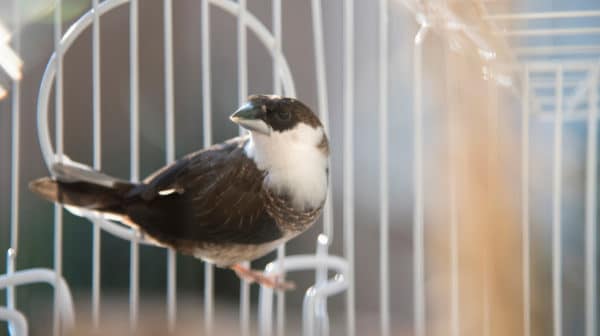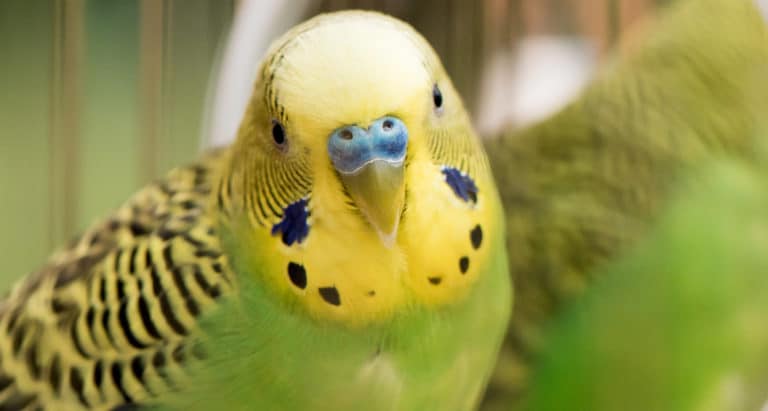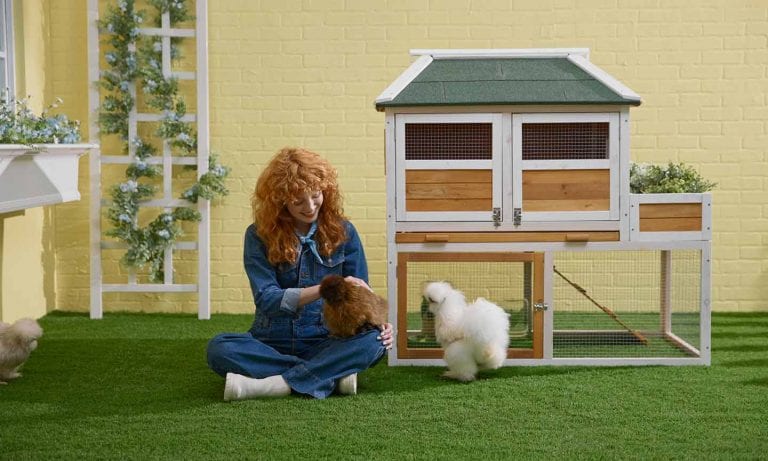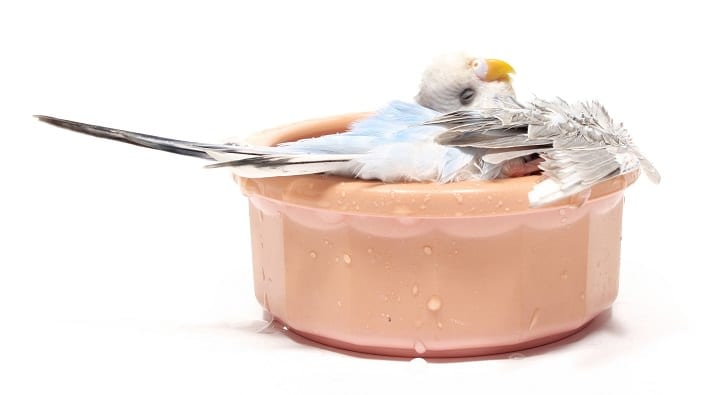Among the many ancient treasures of Asia are wall hangings and paintings showing a variety of species of finches and songbirds, some wild, some caged. A few of these hangings, some many centuries old, depict a finch species apparently already domesticated. It is still being commonly kept all over the world, and it is known nowadays as the Bengalese finch, or the society finch, (Lonchura striata domestica). The name Bengalese is not all that commonly used, so you’ll more often hear these little birds being referred to as society finches.
These charming finches have gregarious natures and are highly sociable. They don’t just enjoy hanging out with each other; they generally enjoy the company of other bird species, too, and they don’t tend to be picky about a bird’s size, shape or habits.
Society finches normally come in a charming variegated pattern of dark chocolate and white, or the fairly common gender-linked recessive color of fawn and white. If you find a good finch breeder, you can usually choose from a range of colors, from all light to all dark, and various colors in between.
Society Finches: Natural Parents
Society finches possess a well-deserved reputation for being relentless in their adoration of baby birds, whether their own or not. Most society finches greatly adore babies and do their best to help rear any baby bird they find, whatever species it happens to be. This appears to be one trait shared by all society finches: the whole flock helps to raise babies. In fact, it’s not uncommon for older hatchlings to help their parents raise younger chicks.
This skill at parenting makes the humble society finches very useful to keep around for babies of rarer finch and waxbill species. If ever there’s a problem with the natural parents not being willing to feed a youngster, usually it’s easily solved as long as there is a nesting pair of society finches around.
Hatchlings that show up in a society finch nest are usually readily accepted and willingly tended to as long as they are vaguely similar in size and appearance to that of a society chick. And by vaguely, I mean just that! I’ve seen societies feed hatchlings roughly four times the size of a society chick of the same age. Large or small, if it’s a baby, most societies will do their best to find a way to feed it.
I once caught a pair of society finches feeding a nestful of canary chicks almost three times as large as themselves. They had to sneak into the canary cage in the first place, mind you, and then the only way they could feed the chicks was to hang upside down on the cage wire above the canary nest. I’m not sure how they figured it all out, but they accomplished their goal.
In fact, I’m not sure if I’ve ever seen anything funnier than when the chicks’ mother showed up to feed her babies, only to realize that the society finches had stuffed her babies so full they could hardly budge. It was quite clear that she was completely at a loss about it all.
Society Finch Courtship And Breeding
Both society finch genders are identical in appearance to the eye, but if you spend a little time sitting and watching them, it becomes quite easy to tell them apart. Male societies are enthusiastic nest-builders and love to display their prowess. Their favorite way to do this is to take a long piece of grass in their beak—the longer, the better—to a stretch of perch near a prospective mate.
The female society finch will usually demurely pretend to ignore him as he commences an antic little dance, beeping an enthusiastic accompaniment while hopping up and down and waving his piece of grass as attractively as he can manage. I’ve often wondered why they don’t fall off their perches in the process; sometimes they can get very enthusiastic about these funny little performances.
Once he’s gotten her complete attention, the male finch takes his dandy piece of grass and makes a huge show of stuffing it into his nest-in-progress, hopefully being watched admiringly all the while. Should her attention wander, he will zip back out with his grass or quickly grab another one like it, and resume his rather manic-looking little grass-dance.
Society males are a little bit haphazard with their nest-building. Most females are willing to put the fine trim on a promising structure (as long as the male does most of the work).
The male constructs his nest anywhere he thinks he can make it work out. When it comes right down to it, all that is really required is someplace that prevents the bottom from falling out of his nest and offers suitable shelter from the sun.
Once everything has been done correctly, his skill, coordination and enthusiasm proves irresistible to his prospective mate, and soon she inspects his carefully built nest. It must prove acceptable before she trims his homemade haven with feathers from both their breasts. Once she has, eggs begin to arrive, often within a couple of days or less. She lays one egg a day until her clutch is complete.
The average clutch size is from four to six eggs, usually with fairly good fertility. These birds can continue breeding as long as conditions and food supplies are suitable, so a single pair of society finches can multiply much more quickly than expected.
Egg-Laying And Fledging
The eggs generally hatch after 12 or 13 days, with both parents sharing incubation and rearing duties. The youngsters fledge at around 20 to 25 days old, but continue to be fed by their parents until they are approximately 6 weeks or so of age—a far longer weaning period than most other similarly sized avian species, another indication of the strong social ties shared within a society finch flock.
As long as there is a reliable food supply, the hens usually lay and begin to incubate another clutch of eggs as soon as the youngsters from the first clutch are barely fledged, long before they are fully weaned. In such a case, the male parent does most of the weaning during the daytime, while the hen spends most of her time incubating her new eggs, coming out only for short periods to eat and exercise while he covers the eggs to keep them from getting chilled.
At sunset, though, it becomes a different story as they all pile into the nest to sleep and share incubation duties, the youngsters as well as both parents. This continues even after the new clutch hatches out; rather than chasing the older youngsters away from their new clutch, as most species do, many society finch pairs allow their youngsters from the first nest to partake in the raising of their younger brothers and sisters. The older chicks carefully mimic their parents’ actions and learn to feed, care for and wean their younger siblings by working alongside their parents.
Society finches have an endearing trait of preferring to sleep together at night—if all they have is a perch, they jam together along it, until six birds look like two. I have seen as many as a dozen society finches cram into a small wicker nest to sleep. From the outside, it looks like the basket is stuffed to the brim with a big ball of feathers. Walk past the nest, though, and a dozen little heads pop out to see what’s going on—it looks like a defiance of the laws of nature to fit all those birds into that tiny space. Yet somehow they manage it, and they seem to enjoy it, too.
Due to their social nature, hand-raised society finches can make remarkably captivating pets, although hand-rearing these tiny creatures isn’t commonly done, as it’s a bit difficult. A recently weaned young society finch is quite easy to hand-tame, if you are patient. Just remain consistent, and follow the taming method outlined on my website. You’ll be rewarded with one of the most outstanding pets you’ll ever know—nothing can wedge its way into the heart quite the way a tame society finch does.
All in all, the gentle, easy-to-keep society finch is a great bird for beginners to start with while learning about aviculture, and a reliable standby for long-time bird owners and breeders, too. This time-tested and enduring species is well-deserving of attention by anybody wanting to keep or breed finches.
Society Finch Basics
Housing
A cage size that is 24 inches long by 24 inches deep by 24 inches high, with bar spacing of 1/2-inch or less. Any 4-inch to 6-inch open or closed nest, nest pan or nest box will do; society finches are remarkably adaptable and not at all picky. Don’t put up nests unless you want young, though, as they will take up the invitation without hesitation!
Food
A standard finch mix, plus some greens daily, anything from chickweed or dandelion, to kale, broccoli or romaine. Appropriate vitamin/mineral supplements are essential, too, but for these birds supplements are better offered dry on a little soft food than in water.
Life Span
Average is 10 years, but it can vary from 2 or 3 years to 20 or more, depending on care, lifestyle, stress (or lack of stress) and genetics.
Companionship
These finches are very social and will pine away without companionship, whether that of people or their own kind. Unless you want to breed them, try for same-gender pairs. One healthy and fertile pair of society finches can easily produce 20 young a year, if allowed. Flying keeps them healthy, and several pairs in a large cage will do better than one or two pairs in a smaller cage. Keep an even number of birds to avoid “odd-bird-out syndrome,” which can be stressful for all.
Color Terminology
There’s occasionally a little confusion with the term “self,” which is used for finches and their relatives, the canaries. This wouldn’t be a problem, except for the fact that this term means different things depending on whether you’re speaking to a finch or a canary person.
The term “self” to most finch breeders indicates a bird that is all one color: it can be all light or all dark and, as long as there is no variegation present, it is considered to be a “self” bird. In canary circles, however, a “self” bird is a bird that is all dark, with no light-colored feathers. Now you know and you won’t be confused when either a finch or canary keeper begins talking about “self” birds.
Society Finch Origins
We don’t know for sure how long it’s been since these little birds were first domesticated, but there are ancient Asian texts close to 10,000 years old that refer to keeping cagebirds. Educated guesses about this species begin at approximately 1,000 years ago and range backward in time.
For years, society finches seemed to be the only domestic species in existence with no counterpart in the wild. While some members of the mannikin finch family look fairly similar, there is no one species that can be clearly identified as a wild Bengalese finch. In fact, nobody seems quite sure just where these tiny yet tough little birds originated!
Nest Location
Most people probably offer their breeding society finches either a small wooden nest box or some version of the slightly larger closed-top woven wicker nests, but I’ve seen these little birds nest in everything ranging from a small, open, cup-shaped nest to a self-built modular home consisting of plenty of hay stuffed into an empty plant hanger.
The latter was particularly interesting to watch being built. The male began by simply stuffing hay into a jute hanger that had held an edible plant I’d removed, planning to replace it with another. I’d left the drain tray behind, but when I came along with the new plant, I found my plans had been pre-emptied, and there was a new “construction project” well under way.
He had a huge heap of hay, perhaps 20 times his size, stuffed into the hanger. He dove in, trampled down a space in the center and then began weaving in an access tunnel that led to a lovely, finely lined central hollow. It was quite the work of art, in its own way. Needless to say, this particular male won over his lady-love’s heart.
Not all male society finches are so successful, but their enthusiasm is boundless, and if their first effort isn’t appreciated, it will quickly be torn down. Soon afterward you’ll find him just as enthusiastically building another structure, once again hoping for his chosen one’s attention and eventual dalliance.
By: Robirda McDonald
Featured Image: via Hanlu Cao/Flickr
Share:










